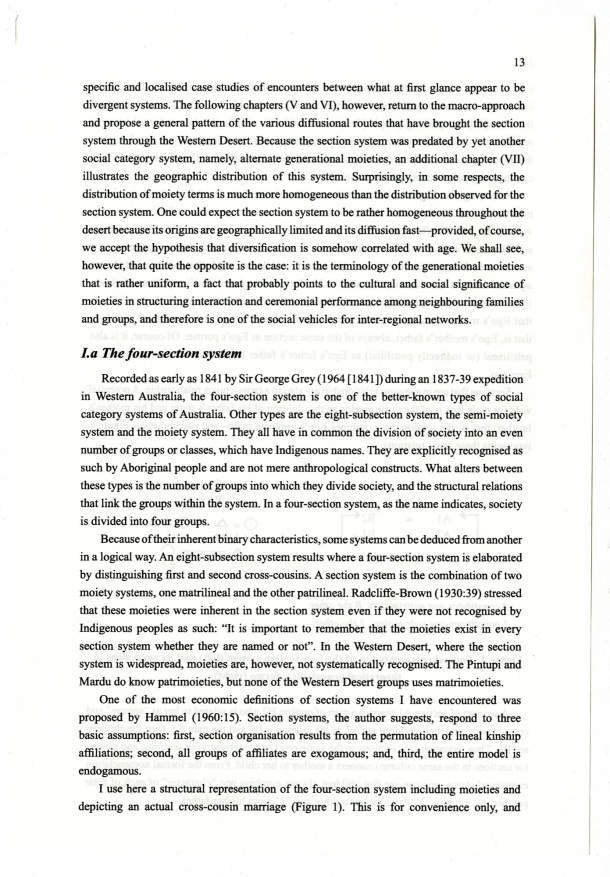|
| 
[Note: this transcription was produced by an automatic OCR engine]
13
specific and localised case studies of encounters between what at first glance appear to be
divergent systems. The following chapters V and VI, however, return to the macro—approach
and propose a general pattern of the various diffusional routes that have brought the section
system through the Western Desert. Because the section system was predated by yet another
social category system, namely, alternate generational moieties, an additional chapter VII
illustrates the geographic distribution of this system. Surprisingly, in some respects, the
distribution of moiety terms is much more homogeneous than the distribution observed for the
section system. One could expect the section system to be rather homogeneous throughout the
desert because its origins are geographically limited and its diffusion fast—provided, of course,
we accept the hypothesis that diversification is somehow correlated with age. We shall see,
however, that quite the opposite is the case: it is the terminology of the generational moieties
that is rather uniform, a fact that probably points to the cultural and social significance of
moieties in structuring interaction and ceremonial performance among neighbouring families
and groups, and therefore is one of the social vehicles for inter-regional networks.
I.a The four-section system
Recorded as early as 1841 by Sir George Grey 1964 [1 841] during an 1837-39 expedition
in Western Australia, the four-section system is one of the better-known types of social
category systems of Australia. Other types are the eight-subsection system, the semi-moiety
system and the moiety system. They all have in common the division of society into an even
number of groups or classes, which have Indigenous names. They are explicitly recognised as
such by Aboriginal people and are not mere anthropological constructs. What alters between
these types is the number of groups into which they divide society, and the structural relations
that link the groups within the system. In a four-section system, as the name indicates, society
is divided into four groups.
Because of their inherent binary characteristics, some systems can be deduced from another
in a logical way. An eight-subsection system results where a four-section system is elaborated
by distinguishing first and second cross-cousins. A section system is the combination of two
moiety systems, one matrilineal and the other patrilineal. Radclifle-Brown 1930239 stressed
that these moieties were inherent in the section system even if they were not recognised by
Indigenous peoples as such: “It is important to remember that the moieties exist in every
section system whether they are named or no ”. In the Western Desert, where the section
system is widespread, moieties are, however, not systematically recognised. The Pintupi and
Mardu do know patrimoieties, but none of the Western Desert groups uses manimoieties.
One of the most economic definitions of section systems I have encountered was
proposed by Hammel 1960215. Section systems, the author suggests, respond to three
basic assumptions: first, section organisation results from the permutation of lineal kinship
afliliations; second, all groups of afliliates are exogamous; and, third, the entire model is
endogamous.
I use here a structural representation of the four-section system including moieties and
depicting an actual cross-cousin marriage Figure 1. This is for convenience only, and
|